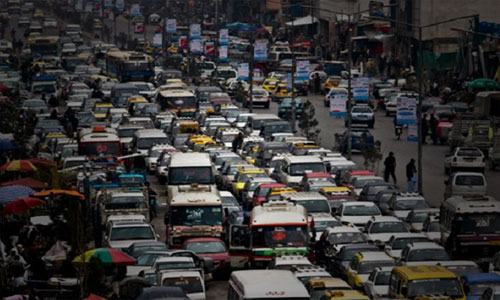Though traffic congestion is one of the most common problems in third world countries, it is more irritating in Kabul rapidly growing city of Afghanistan. Because of various reasons Kabul has become one of the most overcrowded and over-traffic city in the world. The traffic jam has become a never-ending challenge that neither the authorities nor the residents of the city can resolve. The urgent vehicles such as ambulance, fire brigade and patients are hardly possible to reach their destination on time. Sometimes it is said that pregnant woman given birth to her baby inside a car on the way to the hospital or died because of too much waiting or bleeding on the way to the health center. School students, public and private personnel often stuck for several hours behind traffic crowds. The working vendors, carters, porters and parked vehicles often occupy half-side of the roads while the half rest is occupied by the parked cars, especially near the large buildings and big markets. The Traffic congestion affects not only the mobility of people and goods but also the air quality that leads to numerous deaths in the city.
There are many factors behind the issues including unmapped city, narrowness of roads, large number of vendor and hawkers, security walls, lack of parking area, lack of sufficient and transportation system, lack of formal bus stations and so on. In addition, overgrowing population, non-compliance with traffic rules, heavy machinery such as trucks and buses, lack of standard traffic infrastructure, as well as the increasing number of vehicles automatically deteriorates the traffic situation. It is said that Kabul city has the capacity of only 50,000 cars while there are 700,000 vehicles on the narrow streets of Kabul. Thus, annually 30 to 35 thousand vehicles newly enter Kabul city. This article is going to address some of the main factors responsible for the irritating traffics in Kabul city. Firstly, the insufficient public transportation system along with the increase of private vehicles can be considered among the most important contributing factors. Traffic management is extremely poor ever since could not bring significant changes in past 18 years. Roadside assistance such as traffic signs and facilities are rarely seen. Vehicular traffic is disorganized and must contend with numerous pedestrians, bicyclists and each other. With congested roads and abundant pedestrian traffic vehicle accidents are a serious concern and can escalate into violent confrontations. In brief, effective steps are not taken towards traffic infrastructure and management. However, some bus stations have been built in Kabul city but not in use yet. All people have to tolerate the pressing condition and all drivers need to drive defensively with paying close attention to their surroundings.
The second most main factor is narrow roads with unmapped city. Many of the Kabul roads and streets remained from the time when there were few hundred thousand people whereas now there are about 7 million populations. Most often when the government planned to widen the roads with implementing new maps, it faced with resistance of people not to destroy their houses. However, the opposition of those who lost their houses during implementation of maps is a normal issue but in Afghanistan it a very serious. The losers use any options to prevent from the map implementation because the mayor do not compensate the entire expenses imposed on the owner of houses while in other countries the government fully compensate the losses when occurred on the residents as a result of city development. In Kabul, the mayor just gives a plat in a remote area while it never compensates the losses of built houses. Certainly, city development and road expansion are vitally important but its cost must not be imposed on few families whose houses are located on way of road expansion. Even it is very dangerous to suddenly destroy houses of innocent people that they built after years of hard work.
The last major problem is lack of enough parks and parking area in Kabul city. Even go so far as that there is no culture of parking area when someone builds a market and high story building. So, how can we imagine a crowded city with high story buildings beside the narrow roads that half roads are occupied by cars and the half rest is occupied by hawkers, vendors and fruit or vegetable shoppers? In addition, there is no enough green area left in the city. The underground water is excessively used but there is no green area to reabsorb the rain water to save the balance of underground water. According to experts, annually around 22m water is dropped in Kabul city due to unbalanced uses of water. To rescue the Kabul city from the current congested traffics and unmapped city, we need to follow several important points. Firstly, all hawkers and venders must be located to specific areas and leave the main roads. There is no example in the world that main roads are occupied by hawkers. Secondly, all the narrow roads should be expanded and new maps also should be implemented but the government must fully compensate the losses which occurred on the owners of destroyed houses. Thirdly, all high story builds are responsible to think about its parking space. In the meanwhile, the rentable parking areas should be promoted throughout the city. Fourthly, traffic lights and new technologies must be used to regulate the traffics. However, the expansion of narrow roads, parks and parking area with speciation of new location for hawkers in a growing city is hardly possible. It means, the current unregulated city need to be corrected, but the expansions of mentioned areas with rapidly growing population would require the expansion of the entire city in longer term.
Home » Opinion » The Kabul Irritating Traffics: A Never-Ended Problem
The Kabul Irritating Traffics: A Never-Ended Problem
| Mohammad Zahir Akbari

